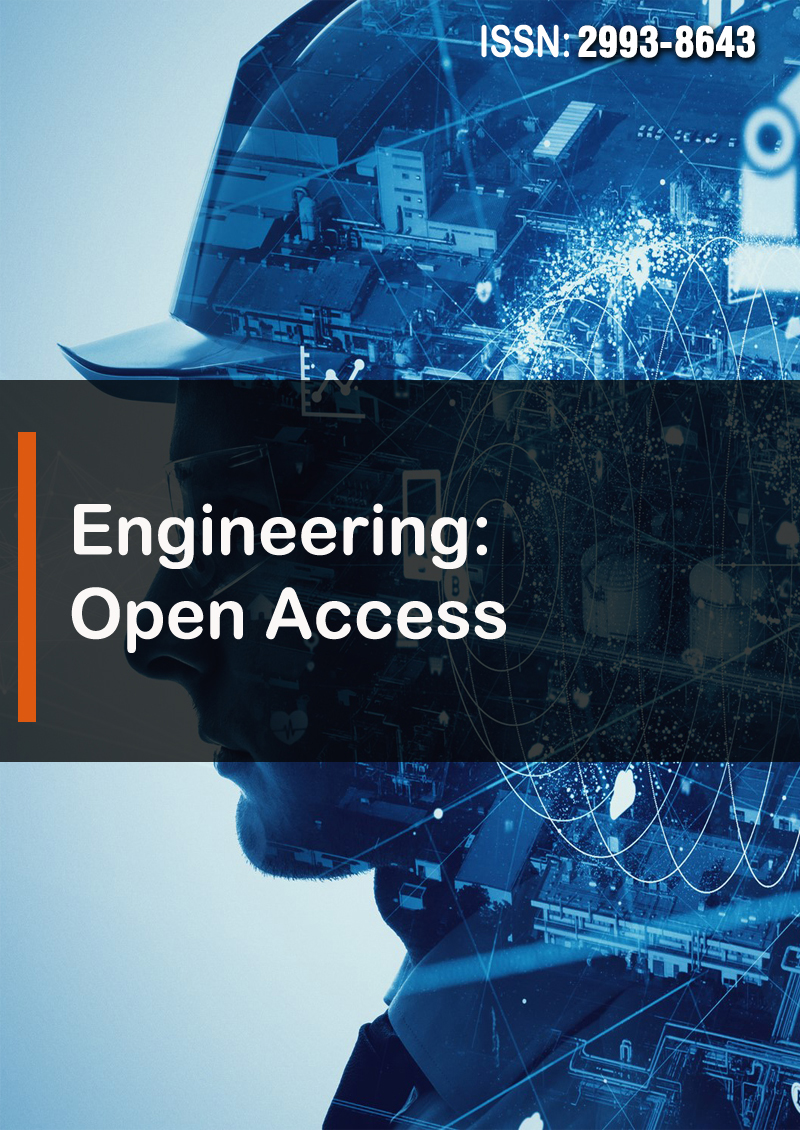Review Article - (2025) Volume 3, Issue 3
Integration of Power Take-Off (PTO) on eAxle for Commercial Electric Vehicles (EVs)
Received Date: Feb 17, 2025 / Accepted Date: Mar 21, 2025 / Published Date: Mar 25, 2025
Copyright: ©2025 Manoj Patil, et al. This is an open-access article distributed under the terms of the Creative Commons Attribution License, which permits unrestricted use, distribution, and reproduction in any medium, provided the original author and source are credited.
Citation: Patil, M., Wankhede, P. (2025). Integration of Power Take-Off (PTO) on eAxle for Commercial Electric Vehicles (EVs). Eng OA, 3(3), 01-05.
Abstract
In response to the evolving landscape of commercial electric vehicles (EVs), we are pioneering the integration of a Power Take-Off (PTO) design and assembly on the e-axle of Commercial Vehicles (CVs). This innovative concept addresses the significant challenges faced by commercial EV manufacturers “The need for auxiliary hydraulic operations without the use of additional motors or external power sources”. This study explores the integration of a PTO unit on the rear axle carrier housing of vehicle, which harnesses power directly from the transmission unit. By powering a hydraulic pump, this solution enables seamless operation of auxiliary hydraulic functions crucial for various commercial applications, like tipping and lifting functions. As leaders in this emerging field, our ongoing development efforts are focused on advancing this concept to market readiness.
Introduction
The transition towards electric propulsion in commercial vehicles necessitates innovative solutions to replicate the functionality traditionally provided by internal combustion engines. One such critical requirement is the ability to power auxiliary hydraulic systems essential for operations such as loading, unloading, and other industrial and mining tasks. Current commercial EV designs often require additional electric motors to drive hydraulic pumps, adding complexity, weight, and cost to vehicle architecture. Our solution aims to streamline this process by integrating a PTO assembly directly onto the eAxle of ILCV vehicles. This approach not only eliminates the need for secondary motors but also optimizes power efficiency and enhances vehicle performance and payload capacity.
Power Take Off (PTO)
It allows to draw energy from the engine (mechanical energy) and converts the power to another equipment, which does not have its own engine or motor. For example: A PTO helps to run jackhammer or a hydraulic jack using a tractor or trucks engine. In the past, PTO used belt drives, drive shafts attachments and pneumatics like bleed air, but a geared transmission is more common today. The PTOs can be of several different typologies, most related to their installation location on the vehicle they are as shown in Figure 1.
Engine Dependent
• Engine Mounted
• Integrated in the Clutch bell housing.
Clutch Dependent
• Driven by the transmission
Transmission Dependent
• Driven by the Transfer box
• Split-Shaft box
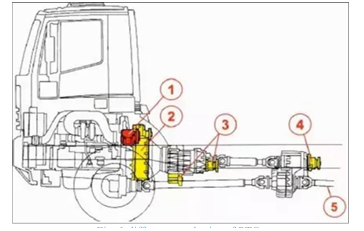
Figure 1: Different Typologies of PTO
Slide Mounted
The PTO is driven by one gear off the lay shaft suitable for regular or heavy duty and intermittent operation see figure 2.

Figure 2: Side mounted PTO
Rear mounted
The PTO is direct driven by splines at the end of the transmission’s lay shaft or alternatively off an extension or auxiliary shaft suitable for heavy-duty continuous operation see figure 3.
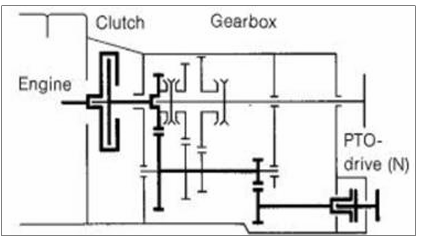
Figure 3: Rear Mounted PTO
Technical Details
PTO Integration on eAxle
- The PTO unit is integrated into the rear axle carrier housing, leveraging the existing powertrain architecture.
- It is designed to efficiently transfer mechanical power from the transmission unit to the hydraulic pump.
Power Transmission:
- Power is derived from the vehicle's main transmission system, ensuring seamless synchronization and control.
- This direct integration minimizes energy losses and enhances overall system efficiency.
Hydraulic Pump Operation:
- The hydraulic pump driven by the PTO unit powers auxiliary hydraulic operations such as lifting mechanisms.
- This functionality is crucial for maintaining operational
Problem Statement
In traditional internal combustion engine (ICE) vehicles, auxiliary hydraulic operations, such as lifting and tipping, are driven by PTO units mounted on the transmission. In electric commercial vehicles, however, an additional electric motor is typically required to power these operations, leading to increased complexity, cost, and energy consumption. Below are few PTO mounting topologies Explained.
PTO Mounting for ICE Vehicles
Transmission-Mounted PTO: These are commonly used in ICE vehicles. The PTO is mounted directly to the transmission and driven by the engine. This setup is straightforward and leverages the vehicle’s existing powertrain, reducing additional components and associated costs.
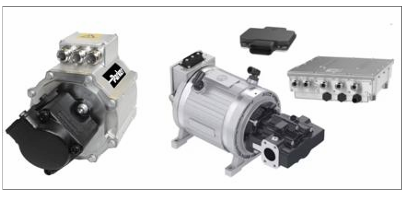
Figure 5: ePTO
Integrated PTO with transmission (Central Drive) Systems:
These systems can be designed to integrate with the vehicle’s existing powertrain, similar to the arrangement in internal combustion engine (ICE) vehicles, where the engine is replaced by a motor. This involves mounting the PTO unit on the gearbox, as shown in Figure 5. The arrangement includes components such as PTO mountings, mounting pads, brackets on chassis for support, and a propeller shaft, although this may reduce axle efficiency.
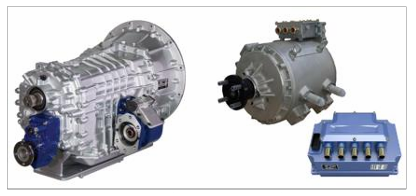
Figure 6: Central Drive System with PTO
Proposed Solution
Our solution involves mounting a PTO unit on the rear axle carrier housing of the eAxle. This PTO assembly draws power directly from the main transmission unit, efficiently running the hydraulic pump necessary for auxiliary operations as shown in figure 7 and Figure 8. this method simplifies the system, reduces the need for extra components, and leverages the existing powertrain infrastructure.
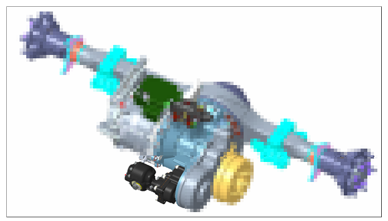
Figure 7: eAxle Transmission Mounted PTO
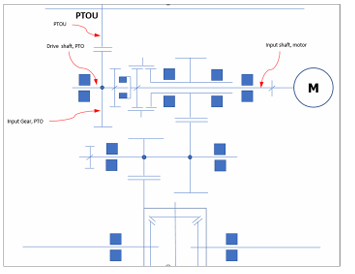
Figure 8: eAxle Transmission Mounted PTO- Line Diagram
Development Process
The proof of concept is currently under development, with several key stages outlined:
Design Phase: Detailed engineering design of the PTO assembly and integration with the eAxle.
Prototyping: Creating prototype units for initial testing and validation.
Testing and Validation: Rigorous testing under various operating conditions to ensure reliability and performance.
Optimization: Refining the design based on test results to enhance efficiency and durability.
Rollout: Preparing for mass production and market introduction.
Application in ILCV
The implementation of the PTO eAxle assembly in ILCVs demonstrates significant improvements in operational efficiency and cost savings. By eliminating the additional electric motor, fleet operators can benefit from reduced maintenance and energy costs, leading to a lower total cost of ownership.
Benefits of the PTO eAxle Integration
Efficiency: By utilizing the main transmission unit's power, the system optimizes energy use, reducing the need for an additional electric motor.
Cost-Effective: Eliminates the expense associated with installing and maintaining a separate motor for auxiliary functions.
Simplicity: Streamlines the design and reduces the vehicle's overall complexity.
Innovation: Positions the company as a leader in the commercial EV market, offering a first-in-market solution that addresses a critical industry need.
Future Prospects
As the commercial EV market continues to evolve, the integration of PTO assemblies on eAxles could become a standard practice, driving further innovations in vehicle design and auxiliary system management. Continued research and development will focus on enhancing the system's capabilities and expanding its application to other vehicle segments.
Conclusion
The integration of a PTO assembly on the eAxle of ILCV vehicles represents a groundbreaking advancement in commercial EV technology. This innovative solution addresses a critical industry challenge, offering significant benefits in terms of efficiency, cost, and simplicity. As development progresses, this concept holds the potential to redefine auxiliary system management in electric commercial vehicles, positioning our company at the forefront of automotive innovation.
Acknowledgement
The authors would like to express their sincere gratitude to all those who have contributed to the development of this project. We thank Mr. Rahul Pardeshi for his invaluable technical support and expertise in the design and integration of the Power Take-Off (PTO) system on the eAxle.
References
1. Patil, M., & Wankhede, P. (2025). Integration of Power Take-Off (PTO) on eAxle for Commercial Electric Vehicles (EVs). Integration, 20, 02-2025.
2. Ramirez, A., & Chavez, F. (2019). Auxiliary Power Systems in Electric Trucks: A Review of Current Practices and Future Trends. Proceedings of the International Conference on Electric Vehicles and Power Systems (EVPS).
3. Wang, Q., Li, Y., & Sun, C. (2022). Efficient Integration of Auxiliary Systems in Electric Vehicles: A Case Study of Hydraulic Systems. Journal of Automotive Engineering, 38(7), 235-245.
4. Chen, M., & Shi, Z. (2020). Energy Efficiency Considerations in Electric Commercial Vehicles: The Role of Power Take Off Systems. IEEE Transactions on Industrial Applications, 56(5), 5923-5931. 5. Xu, J., & Yang, D. (2021). Design of Electric Power Take-Off Systems in E-Trucks: A Comparison of Hydraulic and Electric Solutions. Energy Engineering Journal, 47(2), 189-203.
6. Feng, Y., & Wu, X. (2019). Power Take-Off Integration in Electric and Hybrid Vehicles: Potential Benefits and Challenges. SAE International Journal of Commercial Vehicles, 12(3), 87-98.
7. Carmona, J., & Escalante, L. (2020). Hybrid and Electric Vehicle Systems for Auxiliary Power Generation: A Review of PTO Integration Strategies. Journal of Power Sources, 432(6), 148-162


